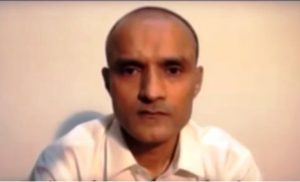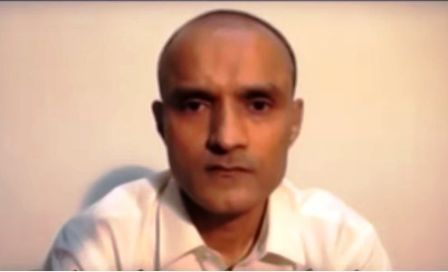On 3 March 2016 a retired Indian Naval Commander Kulbhushan Yadav was arrested in Pakistan on charges of illegal entry into the country via Iran. The arrest was made near the border region of Chaman.
Twenty six days later, on March 29, Civilian and military leaders presented to the media in Islamabad his video confession that he was indeed a spy of India’s external intelligence agency, Research & Analysis Wing (R&AW).
“It is very rare that a country’s intelligence officer is caught in another country,” Lt. Gen. Asim Saleem Bajwa, the military spokesman said as he released the six-minute video. “It is a big achievement,” he said as Pakistan’s minister for Information, Pervaiz Rasheed, nodded his head in appreciation.
Nothing much has been heard since then. India’s Ministry of External Affairs, we are told, had sought consular access to Yadav. The request was rejected. Normally countries are known to disown their spies if they are caught with their pants down. New Delhi did not disown Yadav; in fact, it has come to his rescue publicly, there by picking a hole in the Pakistani narrative. Surprising, yes, indeed, it is, but that is what India did.
Navy Man- Businessman
From what is in public domain, there is no dispute whatsoever that Kulbhushan Yadav served Indian Navy with distinction. On retirement in 2003 he started a ship-based cargo business with headquarters in Mumbai and an office in the Iranian port city, Chahbahar, which acts as a hub for trade with Afghanistan and Central Asia.
India is helping Iran to develop Chahbahar; it is legitimate, therefore, to question as to who between Yadav and Indian government went first to Chahbahar since Pakistan sees Chahbahar as the rival to Gwadar port that China is building on Balochistan coast as its gateway to the energy rich Middle East. But the Yadav family rejects the very question.
“What is there for us to hide? My son talked to us regularly from Iran. Do you think he would dare to talk to us if he was in any hanky-panky business,” his father, Sudhir Yadav, told journalists, who visited him at his residence in a seven-story building in a Mumbai suburb.
He went on to say: “My son’s passport correctly shows this house address, 502B Silver Oak, Powai, Hiranandani Gardens. You can see Iranian visa on his passport. Still how can you say he is a spy? Absurd”. The distraught father pooh-poohed the assertion of Pakistani agencies that Yadav worked at Gadani in Balochistan as a scrap dealer under a false identity.
Enemy number One
Interestingly, even at Gadani, Pakistan finds India as its enemy Number One. Till the 1990s, Gadani was the world’s third largest ship breaking yard with 132 ship-breaking enterprises and 30,000 workers.
Alang in Indian Prime Minister Narendra Modi’s home state of Gujarat has since dethroned Gadani as the major destination for ship breaking. Chittagong in Bangladesh has also come up as a new attraction with the result Gadani today is producing less than one fifth of the scrap it produced three decades ago.
While making public Yadav’s video confession, Asim Bajwa told the media that Yadav converted to Islam, adopted a false identity and worked at Gadani under the cover of a scrap dealer.
“Yadav was administered to establish a network of operatives, provision of funds, and arrange and smuggle people for terrorism into Pakistan, He told the interrogators to use a code phrase—your monkey is with us—in order to inform the Indian authorities about his arrest,” Naveed Ahmad, a Doha-based Pakistani investigative journalist and academic, wrote in The Express Tribune.
Double Trouble?
Truth is always a casualty in any spy narrative. The Yadav saga is no exception. His relatives have picked up the video to pick holes in the Pakistani claims. In the video, Yadav is clean shaven. He is a slightly balding man who did not seem to have undergone the usual interrogation. He appeared confessing voluntarily without much prompting either.
Yadav with his naval background and the orientation of a spy to boot, would not spill the beans suo moto. He could not be unaware of Pakistani reality that confession would in no way guarantees a bail-out. Compounding these doubts, Pakistan denied India consular access to Kulbushan Yadav, and this makes difficult to ascertain the veracity of Pakistan’s claims.
On their part, the Yadav family is unwilling to buy the Pakistan theory. And they h ave been asking whether the Pakistanis used a ‘double’ in the video. Their contention is gaining traction.
ave been asking whether the Pakistanis used a ‘double’ in the video. Their contention is gaining traction.
Right from the Day the ‘Yadav espionage’ broke out, the Yadav family has been saying that he had not been in touch with them for a long while and therefore they had been worried about him. Their concern makes sense if we factor in Pak media reports that Jaish-e-Adil, an Iranian terror group had kidnapped Kulbhushan Yadav for ransom and handed him over to the Afghan Taliban, who, operate as the ISI foot soldiers on either side of Afghanistan –Balochistan border.
From mid-2014 onwards, Pakistan has been vocal in accusing India of interference in Balochistan. The ISI had been on a spree ‘arresting’ so-called R&AW agents in Pakistan and parading them before the media for a long while. But scored no brownie points to the dismay of the Pakistani establishment. Steps in the Jaish-e-Adil with its catch, and ISI sees its manna.
According to another version that found a place in some Indian publications like India Today, the ISI was planning to create a ‘genuine’ Indian agent when in early 2015 it heard about Kulbhushan Yadav in Chahbahar. Kidnapping Yadav was really not an issue. Jaish-ul Adil was roped in for the job. How to ensure that ‘innocent’ Yadav confessed to spying for India? ISI solved the puzzle by creating a “double”, “converting” Yadav to Islam and getting a passport in the name of Hussein Mubarak Patel. An almost Yadav-look alike was zeroed in by the MI office in Quetta, Balochistan, and he played the role to perfection for a fee after some plastic surgery.
Balochistan Chess game
Why should Pakistan go to these great lengths? Islamabad wants to ‘show’ Indian hand in Balochistan, where it has been facing insurgency for more than four-five decades. The Yadav narrative served the purpose.
Balochis live on either side of Iran-Pakistan border. Jaish ul-Adl, (Army of Justice), a Sunni insurgent group based in Sistan-Baluchestan province of Iran, is responsible for several attacks against civilians and military targets. It was founded in 2012. Members of Jundallah, a Sunni militant group floated it after Iran caught and executed their leader, Abdul Malik Rigi. Both Jundallah and its later day incarnation are known to have served Pakistani, Saudi and American interests.
Neither Islamabad nor Rawalpindi is willing to raise a finger at Tehran as they used to do till recently for their Baloch troubles. All because of changing regional dynamics.
Pakistan is no longer positioning Iran as its adversary, nor is it willing to be used as a CIA launch pad for ops into Iran. Today it wants to be on the right side of Iranian leadership. Its short term goal? Iran as an ally in its ambitious China Pakistan Economic Corridor (CPEC). Long term objective? Make Iran join the CPEC and thus neutralize the threat Chahbahar port poses to its Gwadar port.
Now what about Kulbhushan Yadav? Where is the real Yadav, if the Yadav in Pakistani video is a body double? Is he alive? If so, what does Pakistan intend to do with him?
Only Pakistan can provide answers but it has chosen to play blind and deaf game to perfection. Its denial of Indian consular access to Yadav is a clear give away though. Yadav may remain alive somewhere in the Taliban custody till the Yadav narrative has shelf live for Pakistan. In the meantime, the only hope for the Yadav family is that someone would expose Pakistan for what it is: a cradle of terrorism.
(* This article By Malladi Rama Rao appeared first in Oped.com)


